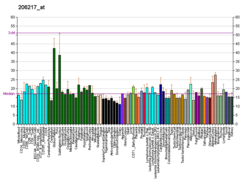Ectodysplasin A (EDA) is a protein that in humans is encoded by the EDA gene.
Ectodysplasin A is a transmembrane protein of the TNF family which plays an important role in the development of ectodermal tissues such as skin in humans. [5] [6] It is recognized by the ectodysplasin A receptor.







